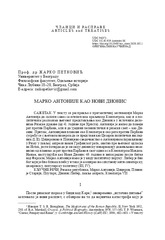Prikaz osnovnih podataka o dokumentu
Marko Antonije kao Novi Dionis
Mark Antony as a New Dionysus
| dc.creator | Petković, Žarko | |
| dc.date.accessioned | 2021-10-12T13:11:47Z | |
| dc.date.available | 2021-10-12T13:11:47Z | |
| dc.date.issued | 2020 | |
| dc.identifier.issn | 0352-5716 | |
| dc.identifier.uri | http://reff.f.bg.ac.rs/handle/123456789/3002 | |
| dc.description.abstract | U tekstu se raspravlja o pragmatičnoj motivaciji Marka Antonija da sklopi savez sa egipatskom kraljicom Kleopatrom, kao i o političkim razlozima njegovog predstavljanja kao Dionisa u istočnim delovima Rimske države (od 41. godine pre Hrista). Antonije je želeo da povede rat protiv Parćana, ali i da ujedini helenistički i rimski svet - kao Dionis. Pritom, Antonijevi planovi oko Kleopatre i oko rata protiv Parćana susreću se s njegovom namerom da se predstavi kao Cezarov politički naslednik (I, II). Ciceronovo i Plinijevo svedočanstvo o Antonijevom pojavljivanju u Rimu u lavljoj zaprezi nakon Građanskog rata, znatno pre njegovog odlaska na Istok, jeste potvrda da je on svoju dionisku inkarnaciju doživljavao nezavisno od planova za rat protiv Parćana i svog odnosa sa Kleopatrom/Izidom. Naime, nastupajući kao Novi Dionis 49. godine i neposredno posle bitke kod Farsale, Marko Antonije imao je u vidu političku poruku: Liber je bio bog koji je bio blizak plebsu i tako je asocirao na sopstvenu anti-senatorsku, cezarovsku, popularsku politiku (III, IV). | SR |
| dc.description.abstract | The Dionysian model as anti-senatorial, plebeian, popularis, and at its last political reading Caesarian, was woven into the political profile of Mark Antony and defined before he appeared in Ephesus in 41 BC as a (New) Dionysus. Namely, it is beyond a reasonable doubt that the lion chariots (mentioned by Cicero, Pliny, and Plutarch in the descriptions of Antony's performance between 49 and 47 BC (?)) were part of the performance of the Dionysian triumph. It does not seem likely that the chariots were part of Herculean iconography, as another possible explanation reads. Introducing himself as Liber in Italy, Mark Antony followed in the footsteps of other populares: C. Marius and Julius Caesar, which was of special importance for Antony. Julius Caesar used Liber - a friend of the Roman plebs, an egalitarian God, a liberator - to establish his position among the lower classes, the position which was represented as anti-senatorial. At a time when Mark Antony publicly appeared as Liber on the streets of frightened Rome, in the early 49 BC, his trip to the East, several years later, meeting and alliance with Cleopatra, and propaganda benefits from the Dionysian processions in Ephesus, Alexandria, and elsewhere were totally unpredictable. When new circumstances took him to the Eastern Roman provinces, Antony was perceived as the heir of the Hellenistic ruling tradition, as a triumphant, victorious in the East but also a unifier of the East and West. So, Antony appeared to be the reincarnation of Dionysus. | EN |
| dc.publisher | Matica srpska, Novi Sad | |
| dc.rights | openAccess | |
| dc.source | Zbornik Matice srpske za istoriju | |
| dc.subject | Rimska republika | SR |
| dc.subject | Plutarh | SR |
| dc.subject | Plinije Stariji | SR |
| dc.subject | Marko Antonije | SR |
| dc.subject | lavlja zaprega | SR |
| dc.subject | Kleopatra VII | SR |
| dc.subject | Dionis/Liber | SR |
| dc.subject | Ciceron | SR |
| dc.subject | Roman Republic | EN |
| dc.subject | Plutarch | EN |
| dc.subject | Pliny the Elder | EN |
| dc.subject | Mark Antony | EN |
| dc.subject | lion chariots | EN |
| dc.subject | Dionysus/Liber | EN |
| dc.subject | Cleopatra VII | EN |
| dc.subject | Cicero | EN |
| dc.title | Marko Antonije kao Novi Dionis | SR |
| dc.title | Mark Antony as a New Dionysus | EN |
| dc.type | article | |
| dc.rights.license | ARR | |
| dc.citation.epage | 19 | |
| dc.citation.issue | 102 | |
| dc.citation.other | (102): 9-19 | |
| dc.citation.rank | M51~ | |
| dc.citation.spage | 9 | |
| dc.identifier.doi | 10.18485/ms_zmsi.2020.102.1 | |
| dc.identifier.fulltext | http://reff.f.bg.ac.rs/bitstream/id/1628/2999.pdf | |
| dc.type.version | publishedVersion |

